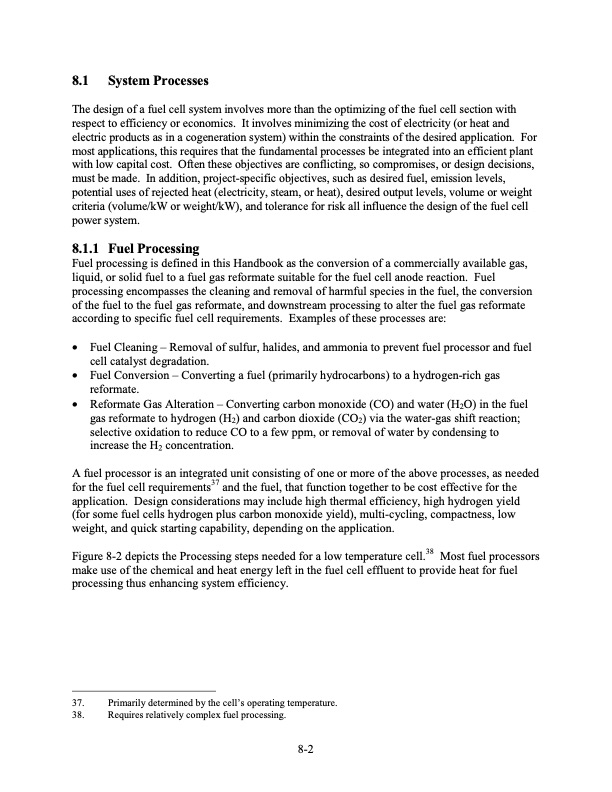
PDF Publication Title:
Text from PDF Page: 247
8.1 System Processes The design of a fuel cell system involves more than the optimizing of the fuel cell section with respect to efficiency or economics. It involves minimizing the cost of electricity (or heat and electric products as in a cogeneration system) within the constraints of the desired application. For most applications, this requires that the fundamental processes be integrated into an efficient plant with low capital cost. Often these objectives are conflicting, so compromises, or design decisions, must be made. In addition, project-specific objectives, such as desired fuel, emission levels, potential uses of rejected heat (electricity, steam, or heat), desired output levels, volume or weight criteria (volume/kW or weight/kW), and tolerance for risk all influence the design of the fuel cell power system. 8.1.1 FuelProcessing Fuel processing is defined in this Handbook as the conversion of a commercially available gas, liquid, or solid fuel to a fuel gas reformate suitable for the fuel cell anode reaction. Fuel processing encompasses the cleaning and removal of harmful species in the fuel, the conversion of the fuel to the fuel gas reformate, and downstream processing to alter the fuel gas reformate according to specific fuel cell requirements. Examples of these processes are: • Fuel Cleaning – Removal of sulfur, halides, and ammonia to prevent fuel processor and fuel cell catalyst degradation. • Fuel Conversion – Converting a fuel (primarily hydrocarbons) to a hydrogen-rich gas reformate. • Reformate Gas Alteration – Converting carbon monoxide (CO) and water (H2O) in the fuel gas reformate to hydrogen (H2) and carbon dioxide (CO2) via the water-gas shift reaction; selective oxidation to reduce CO to a few ppm, or removal of water by condensing to increase the H2 concentration. A fuel processor is an integrated unit consisting of one or more of the above processes, as needed for the fuel cell requirements37 and the fuel, that function together to be cost effective for the application. Design considerations may include high thermal efficiency, high hydrogen yield (for some fuel cells hydrogen plus carbon monoxide yield), multi-cycling, compactness, low weight, and quick starting capability, depending on the application. Figure 8-2 depicts the Processing steps needed for a low temperature cell.38 Most fuel processors make use of the chemical and heat energy left in the fuel cell effluent to provide heat for fuel processing thus enhancing system efficiency. 37. Primarily determined by the cell’s operating temperature. 38. Requires relatively complex fuel processing. 8-2PDF Image | Fuel Cell Handbook (Seventh Edition)

PDF Search Title:
Fuel Cell Handbook (Seventh Edition)Original File Name Searched:
fuel-cell-handbook.pdfDIY PDF Search: Google It | Yahoo | Bing
NFT (Non Fungible Token): Buy our tech, design, development or system NFT and become part of our tech NFT network... More Info
IT XR Project Redstone NFT Available for Sale: NFT for high tech turbine design with one part 3D printed counter-rotating energy turbine. Be part of the future with this NFT. Can be bought and sold but only one design NFT exists. Royalties go to the developer (Infinity) to keep enhancing design and applications... More Info
Infinity Turbine IT XR Project Redstone Design: NFT for sale... NFT for high tech turbine design with one part 3D printed counter-rotating energy turbine. Includes all rights to this turbine design, including license for Fluid Handling Block I and II for the turbine assembly and housing. The NFT includes the blueprints (cad/cam), revenue streams, and all future development of the IT XR Project Redstone... More Info
Infinity Turbine ROT Radial Outflow Turbine 24 Design and Worldwide Rights: NFT for sale... NFT for the ROT 24 energy turbine. Be part of the future with this NFT. This design can be bought and sold but only one design NFT exists. You may manufacture the unit, or get the revenues from its sale from Infinity Turbine. Royalties go to the developer (Infinity) to keep enhancing design and applications... More Info
Infinity Supercritical CO2 10 Liter Extractor Design and Worldwide Rights: The Infinity Supercritical 10L CO2 extractor is for botanical oil extraction, which is rich in terpenes and can produce shelf ready full spectrum oil. With over 5 years of development, this industry leader mature extractor machine has been sold since 2015 and is part of many profitable businesses. The process can also be used for electrowinning, e-waste recycling, and lithium battery recycling, gold mining electronic wastes, precious metals. CO2 can also be used in a reverse fuel cell with nafion to make a gas-to-liquids fuel, such as methanol, ethanol and butanol or ethylene. Supercritical CO2 has also been used for treating nafion to make it more effective catalyst. This NFT is for the purchase of worldwide rights which includes the design. More Info
NFT (Non Fungible Token): Buy our tech, design, development or system NFT and become part of our tech NFT network... More Info
Infinity Turbine Products: Special for this month, any plans are $10,000 for complete Cad/Cam blueprints. License is for one build. Try before you buy a production license. May pay by Bitcoin or other Crypto. Products Page... More Info
| CONTACT TEL: 608-238-6001 Email: greg@infinityturbine.com | RSS | AMP |